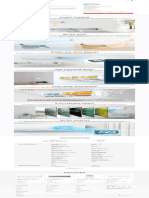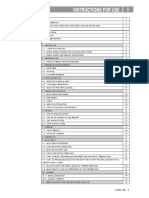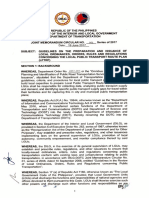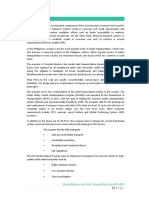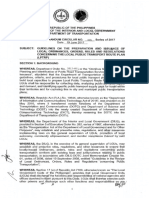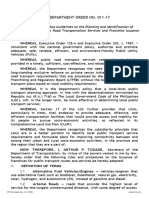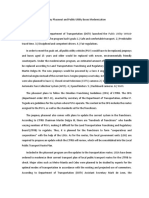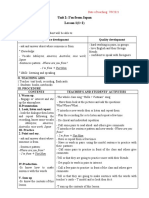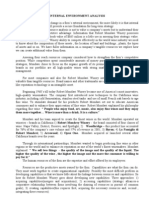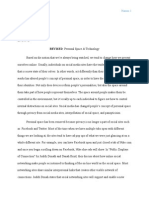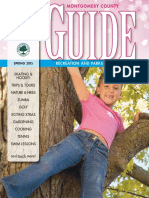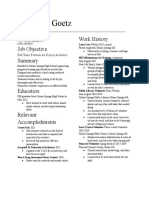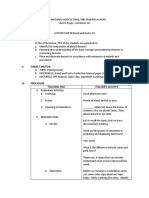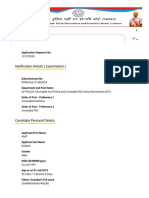Public Utility Vehicle Modernization Program
Frequently Asked Questions
A. What are the benefits of the Program?
1. Improved public transport level of service, passenger and commuter welfare.
2. Congestion reduction especially in highly urbanized areas.
3. New jobs and opportunities.
4. Improved driver, commuter, and passenger welfare.
B. How are operators selected?
1. Once there is an approved LPTRP, the concerned LTFRB Office will now publish its call
for application.
2. Individual operators and drivers in the identified routes, who decide to continue in the
industry, shall now form into a legal entity such as a cooperative or corporation.
However, consolidation even before the issuance of the LTFRB’s call for application is
not prohibited
3. After consolidation, the legal entity can now apply and submit the documentary
requirements to the LTFRB. Existing operators in their particular routes are given priority
in franchise processing.
4. On the other hand, those who decide to voluntarily exit from the industry may avail of
the social support programs offered by the DOTr under the PUV Modernization
Program’s Social Mechanism Component.
C. Is the moratorium lifted?
Yes. Upon the issuance of the Omnibus Franchising Guidelines (OFG), the moratorium issued
by the Department of Transportation in 2003 was lifted. However, before new franchises are
issued, routes must be rationalized based on passenger demand. Once the LPTRP is completed
and approved, then the franchises are now open for application.
D. How is the LPTRP Approved?
Steps Agency
Concerned
Step 1: Draft the LPTRP LGU
Step 2: Submit the LPTRP to the LTFRB LGU
Step 3: Review the compliance of the LPTRP with the OFG LTFRB
Step 4: Issue an NOC or an NONC depending on the results of the LTFRB
review
Step 5: LGU
• If an NOC is issued, pass an ordinance adopting the LPTRP and
endorse the same to the LTFRB
• If an NONC is issued, revise the LPTRP
Step 6: Conduct a transparent operator selection and issuance of LTFRB
franchise(s).
E. Why LGU capacity building?
1. The Department is mandated to provide policies and plans with respect to the planning
and identification of routes.
2. Lack of manpower and technical expertise in DOTr to conduct nationwide route planning.
3. LGUs identify local public transport service requirements in accordance with their
Comprehensive Land Use Plan, Zoning Plans, and Traffic Management Plans, the LGUs
are being engaged in the conduct of their their LPTRPs.
4. LGUs are in a better position to identify local public transport service requirements being
in-charge of formulating the Comprehensive Land Use Plan, Zoning Plans, and Traffic
Management Plans.
F. If LGU refuses/fails to make LPTRP, what will happen?
1. Pursuant to the OFG, “ln case the LGU is not ready to take on the responsibility for public
transport route planning in its domain, or if an approved LPTRP for the city or municipality
is not yet available, the Department can determine the routes and services for which
franchises shall be issued by LTFRB.”
2. Per the OFG, the DOTr is responsible for these LGUs.
G. Why is there a need to rationalize the routes?
There is currently an oversupply/ undersupply of PUVs in most of the routes which leads to low
income and inefficiency of service on the part of the operators and drivers.
H. Very simple explanation of route rationalization. What is the objective?
Route rationalization shall be conducted to ensure that routes are properly planned in
accordance with passenger demand, the appropriate type and number of units serving the route,
and financial viability of operations. The output of route rationalization studies are as follows:
1. Organized routes
2. Transport Mode (ex: Bus, PUJ, etc.) and number of units
3. Location of stops
I. Saan kami ilalagay if overserved and underserved ang route?
1. Existing franchise holders will be given preferential treatment when applying for the
rationalized routes, provided that they comply with the provisions of the OFG (e.g.
consolidation, fleet modernization, fleet management, etc).
2. Operators from overserved routes may transfer to other routes (developmental or
underserved routes), provided that they also apply for membership to the existing legal
entities in such routes.
J. Apprehension on LGU intervention. Mapupulitika ba ang LPTRP?
1. In line with Sec. 25 (b) of R.A. No. 7160, national agencies and offices with project
implementation functions shall ensure the participation of LGUs both in the planning and
implementation of national projects.
2. Under the OFG, franchise issuance remains a function of the LTFRB. Only the
conduct of transport studies was validly delegated to the LGUs since they are in a
better position to identify local public transport service requirements being in-charge of
formulating the Comprehensive Land Use Plan, Zoning Plans, Traffic Management
Plans, etc.
K. What if the operators fail to follow fleet requirements?
Under the OFG, individual operators who fail to follow fleet requirements are allowed to operate
during the transition period. However, they must integrate their operations management,
including dispatching and safety inspection, with other operators such that the OFG fleet
requirements are met.
L. What standards are being released by the Philippine government?
The vehicle standards that were set by the DTI’s Bureau of Product Standards (BPS) covers
dimensional standards on the height, spacing between seats, door width and door location, etc.
which should be complied with by vehicle manufacturers of the modern jeepneys.
M. Who formulated the PNS Standards?
The Philippine National Standard (PNS 2126:2017) for Class 2 and 3 PUVs were developed by
an inter-agency technical committee with representatives from government agencies, academic
institutions, transport operators, and even the manufacturer associations. The committee based
the standards on UN-ECE regulations which is adopted worldwide to ensure safety and
convenience to passengers and drivers.
N. What is Industry Consolidation?
Refers to strategically merging smaller transport industry players to form legal entities such as
cooperatives, corporations, and consortiums.
This aims to reform the existing unorganized practice wherein most transport operators own a
single unit and operate independently, thereby resulting to the inefficient deployment of vehicles
on the road and competition for passengers. Consolidation will provide opportunities for
organized operations and effective fleet management that will offer better services to the riding
public
O. What are the benefits of the Industry Consolidation?
1. Operational Efficiency savings from Organized Dispatching System and a more
systematic Fleet Management
2. Consolidation allows spreading of Capital Expenses and Operating Expenses, leading
to further decrease in Operations and Maintenance Costs.
3. Easy access to vehicle financing
4. Maximizes revenue while keeping maintenance costs low
5. Improves collection and lesser risk (efficient multiple trips)
6. Access to more discounts in fuel and spare parts
7. Access to common garage/depot
8. Can obtain franchise easily than single operator
9. Has dividend and membership benefits
P. How are we going to finance the new units?
The LBP and DBP provided loan programs with low downpayment, low interest rates, and long
payment period. With features as follows:
1. 5% - Equity (or the Php 80,000 subsidy)
2. 6% - Interest rate
3. 7 years to pay
Q. What will happen to the old jeepney units?
The DOTr will be endorsing DTI and DENR-accredited scrapping companies who will purchase
the old PUVs for a fee. The scrap value is envisioned to add to the budget of the PUV owners
and operators in buying modern PUVs.
R. Who can avail this social support?
All existing drivers, operators and/or their chosen beneficiaries, are entitled to this social support.
S. What will happen if we continue operating or driving jeepneys?
For those who will continue (consolidate and be given franchises), free skills training from TESDA
will be provided. One (1) slot per member (both operator and driver) of corporations, and two (2)
slots per member of cooperatives. These slots can be transferred to family members up to 3rd
degree of affinity or consanguinity.
T. What will happen to the driver/operator who choose to opt out of the transport industry?
For those who will choose to seek employment or to start their own business/enterprise, the
DOTr, in partnership with TESDA and DOLE, will be providing skills and livelihood training, job
matching, and entrepreneurship programs, with proper monitoring and guidance.
Beneficiaries may choose their course and an allowance of Php 350/day will be provided for
every day of attendance.
Further, DSWD’s Sustainable Livelihood Program and DTI’s Microfinance/Small and Medium-
Sized Enterprises Development will also be available for these affected stakeholders.
U. Can the social support programs be extended to the operators’ and drivers’ family and
relatives?
Yes. Our social support programs is extended to the spouse, child, or relative up to 3rd level of
consanguinity or affinity of the operators and drivers.
V. What will happen to tricycle franchises pending the approval of the LPTRP?
A moratorium on the acceptance of applications/petitions for tricycle franchises shall be
implemented by all LGUs, upon the effectivity of this JMC, pending the approval of its LPTRP.
W. What will happen to tricycles once the LPTRP is approved?
To ensure that the hierarchy of public transport modes envisioned in the OFG is preserved, the
guidelines on the granting of franchises to tricycles prescribed in Section 3.1 of DILG-DOTC JMC
No. 1, series of 2008 shall be strictly observed in the preparation of the LPTRP. The following
provision shall be strictly monitored in the evaluation of the LPTRP, to wit:
“Tricycle operation should only be confined along city or municipal roads, not along national
roads and is limited only to routes not traversed by higher modes of public transport. However,
the local Sanggunian may allow if there is no other alternative route."
This means that the LGU LPTRP shall ensure that tricycle operations are limited to routes where
there are no other modes of public transportation (e.g. Filcabs, Jeepneys, Buses, AUVs, etc).
Tricycle operations shall complement, not compete, with higher modes of transportation.
This will ensure that the trunk and feeder system is applied in the LGU level.














